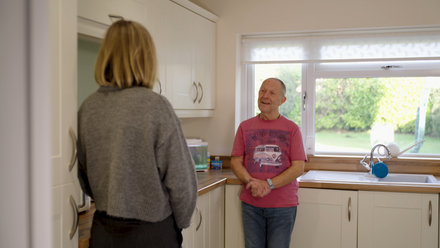We know that achieving a healthier weight can be a challenge and maintaining a healthier weight can be difficult too. This fact sheet will support you to get started and keep going. Here you’ll find advice and tools that will help you to achieve the goals you want.
This food fact sheet is aimed at individuals living with overweight or obesity to help them move towards a healthier weight. BMI is sometimes used as a guide; you can find out your BMI here to see if this food fact is appropriate for you.

Why is being a healthier weight important?
About 63% of UK adults are living with overweight or obesity. If this includes you, we know that losing just 5-10% of your weight has positive health benefits including reduced risk of type 2 diabetes, heart disease and some cancers. Losing inches from your waist also helps to lower your risks of obesity related conditions.
Where to start?
The first question to ask yourself is: “do you feel ready to start your weight loss journey?”
If the answer is ‘yes’, this fact sheet will help you. If now’s not the right time for you, you can still use this fact sheet when you feel ready to do so.
Setting a goal and action plan
Being clear about what you want to achieve and setting well-defined, measurable goals is key to success.
If your goal is to lose weight, set yourself a realistic weight loss goal. Realistic goals are more achievable, and success boosts confidence in your ability to lose weight and continue to do so. A weight loss of between 5-10% over three to six months or one to two pounds (0.5-1 kg) per week is a realistic target.
Think also about 'non-scale' victories you would like to achieve. These might be sleeping better, being more active with your children, taking the stairs without getting out of breath or being in less pain.
Choose two or three small changes you can start with and write yourself an action plan with clear goals to follow, for example:
‘I will aim to eat more vegetables and do this by having two portions of vegetables per day, one at lunch and one at dinner. I will measure this by writing it down, and I will start tomorrow.’
When successful, you can move on to more changes or build on the ones you’ve already established.
Monitoring yourself
People that keep track of themselves regularly are more successful at keeping weight off. Evidence shows people who weigh themselves once or twice a week lose more weight. But only do this if you are happy to. If not, then consider using your clothes as a guide or measuring your waist or hips.
Keeping a food diary can help you to be aware of your eating habits and can help support you in choosing small changes to make, helping you to feel more in control of your eating. In this diary, record what you eat and drink, at what times, who you’re with and how you were feeling. For example, ‘a cup of tea with one teaspoon of sugar and semi-skimmed milk and a biscuit at 3pm (feeling stressed)’. By looking back over this you will be able to see how times, places, people, and your mood affect your food intake. You can also record your activity, to keep track of your progress. A key tip is to complete the diary at the same time as your meals or snacks.
Following a healthier eating plan
It is important not to follow ‘fad diets’. ‘Fad diets’ are often extreme, overly restrictive, nutritionally unbalanced and hard to stick to in the long run. Instead, aim for a healthier balanced eating plan.
- Plan ahead to ensure you have healthier foods to hand, at the right times.
- Aim to reduce your portion sizes (but not of vegetables) by reducing your plate size.
- Aim to have three regular, balanced meals a day. Try to have meals at planned times during the day and only include snacks if you are physically hungry.
- Fill half your plate with vegetables/salad and divide the other half between lean meat, fish, egg, tofu, Quorn or beans and starchy foods like potatoes, wholegrain rice, chapatti, yam, pasta or bread.
- Be mindful of foods that are high in fat and added sugar and limit sweet, fatty and salty snacks.
- Avoid eating while you are doing other things, like working, reading, or watching TV. This can result in overeating.
- Eat slowly, concentrate on and really taste and savour/enjoy your food.
- If you drink, moderate your alcohol intake. Alcohol is high in calories (often higher than we think!), doesn’t fill us up the same as food does and can lead to less healthy choices.
Be more active
Aim to minimise the amount of time you are sedentary (e.g. sitting or lying down) during the day. Slowly build up the amount of activity you do so that it becomes part of your daily routine. Find things you enjoy doing, so it is easier to keep doing them. Walking more is often a good way to start, especially with a friend.
Look for easy ways to fit more movement into your day-to-day routine. For example, stand up when on the phone, park a bit further away from your destination, take the stairs or get off the bus a stop earlier.
Though evidence shows that physical activity does not cause significant weight loss, it is important in helping you keep the weight off long term. It also brings a whole host of other benefits for both physical and mental health.
While on your weight loss journey
Making lifestyle changes is not plain sailing; often life circumstances can throw up challenges that can send us off track. It’s ok if we go off track now and then. Use it as a learning opportunity by reflecting on what went wrong and how you might manage it differently next time.
A good way to think about things is the 80:20 approach. This means choosing a healthier lifestyle 80% of the time, and allowing yourself more flexibility for the remaining 20%.
Get the support that is right for you – it makes all the difference. For example, ask a friend to go to an exercise class with you or ask your partner not to buy you food as a gift.
Remember, there is no quick fix. People who successfully lose weight and keep it off set personal goals and develop skills to make their new lifestyle and activity habits an enjoyable way of life.
Top tips
- Set two to three clear, well-defined, measurable goals, and action plans.
- Monitor yourself.
- Aim for three regular, balanced meals a day.
- Aim for half your plate to be vegetables/salad and divide the other half between protein and carbohydrate.
- Eat slowly, concentrate, and enjoy your food.
- Be more physically active.
- Accept that life circumstances can throw up challenges and are part of lifestyle change and keep positive.
- Get support to help you along your journey.
Source(s)
NHS Digital. (2020) Statistics on Obesity, Physical Activity and Diet, England, 2020 https://digital.nhs.uk/data-and-information/publications/statistical/statistics-on-obesity-physical-activity-and-diet/england-2020/part-1-obesity-related-hospital-admissions-copy [Accessed 5 November 2021]
England Health Survey (2019-2020) https://digital.nhs.uk/data-and-information/publications/statistical/health-survey-for-england [Accessed 5 November 2021]
Scottish Health Survey (2019-2020) https://www.gov.scot/collections/scottish-health-survey/ [Accessed 5 November 2021]
DHSC (2020) Tackling obesity: empowering adults and children to live healthier lives https://www.gov.uk/government/publications/tackling-obesity-government-strategy/tackling-obesity-empowering-adults-and-children-to-live-healthier-lives [Accessed 5 November 2021]
Canadian Obesity Guidelines (2020) https://obesitycanada.ca/guidelines/chapters/ [Accessed 5 November 2021]
Schutz et al. (2019) European Practical and Patient-Centred Guidelines for Adult Obesity Management in Primary Care
Clare Grace on behalf of BDA Specialist Obesity Group (2018) A review of one-to-one dietetic obesity management in adults.
Yumuk et al. (2015) European Guidelines for Obesity Management in Adults
NICE (2014) Obesity Update CG189
Obesity in Scotland (2010) A national clinical Guideline for use in Scotland by the Scottish intercollegiate Guidelines Network (SIGN 8). Sign Edinburgh. www.sign.ac.uk. [Accessed 5 November 2021]
National Institute of Clinical Excellence (2006) CG43 http://www.nice.org.uk/CG043 [Accessed 5 November 2021]
Clinical Guidelines on the identification, Evaluation and treatment of Overweight and Obesity In Adults (1998) by the National Heart, Lung and Blood institute (USA). http:/nih.gov/guidelines/obesiity/obhone.htm
Manual of Dietetic Practice. Obesity/CBT Chapters 4. 17, 4.18. Pg 463 – 483
Shape-up (2001) A lifestyle programme to manage your weight by Jane Wardle et al. Weight Concern: London. www.weightconcern.com. [Accessed 5 November 2021]
Tackling Obesity in England (2001). Report by the comptroller and Auditor General . National Audit Office. Available from The Stationary Office London.
Foresight Report (2007) Tackling Obesities http://www.bis.gov.uk/foresight/our-work/projects/published-projects/tackling-obesities [Accessed 5 November 2021]
Collins (2006) Need to Know – NLP by Carolyn Boyles, Collins: London
Costain L & Croker H. Helping individuals to help themselves. Proceedings of the Nutrition Society 2005; 64, 89-96.
Wing RR, Hill JO. Successful weight loss maintenance. Annu Rev Nutr. 2001; 21: 323-41.
Wing RR, Phelan S. Long-term weight loss maintenance. Am J Clin Nutr. 2005 Jul;82(1 Suppl):222S-225S.
British Dietetic Association Specialist Obesity Group www.bda.uk.com [Accessed 5 November 2021]
National Weight Control Registry http://www.nwcr.ws/ [Accessed 5 November 2021]







